Here’s the deal on Clematis care! The Clematis vine – is a gorgeous plant in any garden. Growing clematis pronounced (Klem’-a-tis) can add lots of color to your garden, and with many different sizes, you can fit one in any garden.
Many clematis vines reach out 10′ to 30′ feet or more. The small-flowered climbing species, frequently rampant growers, make ideal coverings for fences, pergolas, porches and walls.
They ramble informally over rocky slopes and tree stumps, and excel where luxuriant new growth is desired.
The handsome less vigorous large-flowered hybrids work well for covering trellises, arbors, pillars and lamp posts.
Grow clematis outdoors in containers for movable color accents. The vines can be forced in a greenhouse or sunny room without much difficulty.
Clematis also come in smaller varieties as well. If you don’t have the room for larger varieties, use smaller shrubs sized varieties on your deck or patio.
Where To Grow Clematis Vines
Clematis vines are considered to be some of the best perennial vines for the garden growing. Grow Clematis in partial shade, but you’ll enjoy finer flowers if the top growth gets full sun.
Always keep roots shaded. A cool root-zone is essential for the surface-feeding roots. Low-growing, shallow-rooted plants around the base of the vines provide a natural and attractive protection.
Protection from high winds insures against stem breakage, which encourages disease. Select a situation where trees or buildings provide a natural windbreak.
Consider Your Area And Plant Size Carefully
Below buying or planting ask yourself this question. “How tall of a variety of Clematis can my space handle?” Some clematis varieties grow much taller than others and require some type of support like a trellis for your clematis to climb.
Flowers also come in a variety of colors and sizes, from medium to large sized and six to nine inches across.
Once you’ve answered these questions, you’re ready to select your plants. If you have room for a vine 10 – 20 feet in length or height, you’re sure to appreciate the variety of clematis available.
However, before you begin the process of choosing which clematis variety to place in your garden, ensure that it will receive up to six hours of sun in the location you select.
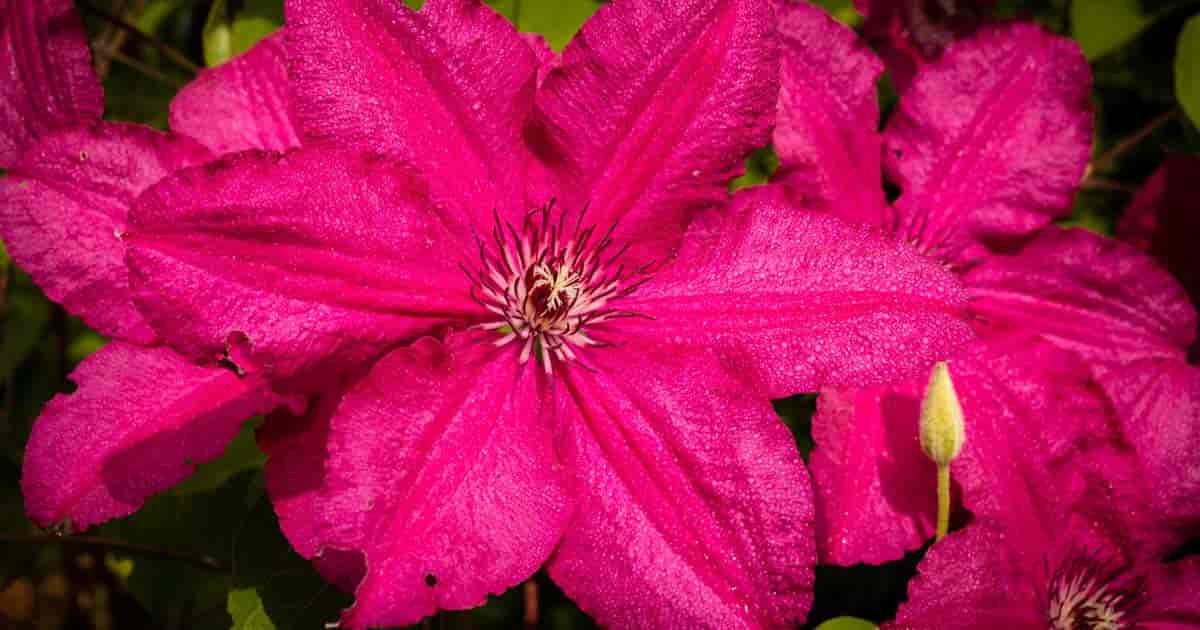
What To Look For When Buying A Healthy Clematis Vine
When shopping for clematis, consider all your options before you buy.
- Look for plants in at least 1 gallon containers.
- Choose a plant that looks healthy and robust.
- Check for vigorous growth.
- Purchase two or more clematis at a time to ensure good solid new growth going in the area they are planting in.
Details On The Clematis Flower
Standard clematis blooms sport six to seven petals on it and can measure anywhere from five to nine inches across.
A few varieties have smaller flower size but most homeowners like the large flower varieties. Some varieties sport double blossoms and bell type flowers which also make unique additions to the garden.
Choose from a wine red flower to a lavender or deep purple. Some varieties even lean toward the yellow spectrum as well.
It’s important to note that the purple clematis vine will take a number of years before it fully matures and flower vigorously. If you’re in a hurry, you may wish to consider purchasing a two or three-year-old plant.
How To Care For Clematis
Proper soil preparation is essential for caring for clematis.
Proper soil preparation is essential for healthy, attractive clematis vines. Click to Tweet
Clematis grow best in a moist, well-drained soil with a neutral to a slightly alkaline soil pH. If your soil runs more acidic soil, sweeten it up with some lime or wood ash.
Clematis Planting Tips
Below you’ll find several recommendations for planting clematis. As you’ll see… no “perfect” formula exist. However, growing these wonderful vines involves a long term commitment.
Our advice: Take the time to prepare the planting location well!
Don’t just dig a hole larger than the container, put in some compost along with a bit of synthetic or organic granular fertilizer, water and walk away.
Planting Recommendation #1:
Dig the planting hole 2-1/2 feet deep and 1-1/2 feet wide. Put 6 inches of crushed stones or other drainage material in the bottom of the hole and fill it with fertile soil mixed with sand, leafmold, a spadeful of agricultural lime and 2 spadefuls of bonemeal. The use of manure is apt to induce wilt.
Planting Recommendation #2:
Dig a hole 18 inches wide and equally deep. At the bottom place a deep layer of humus or a mixture of soil, sand, peatmoss, leafmold or other organic material. If soil is not sweet, add some lime to mixture.
Spread out the plant roots, making sure that the collar of the plant is at least 2 or 3 inches below the surface of the soil. Firm the soil lightly and water well.
Cover the root area with a light mulch of peatmoss, sawdust, or leaves. But do not use leaves in the Northwest where the winters are mild and moist, since they would pack into a soggy mass.
Once planted, give them support with a permanent trellis. Clematis stems are brittle and will break in the wind unless supported.
Planting Recommendation #3: With a Cool Limestone Rock Trick
A method reportedly used by some English gardeners has been to sink a fairly large soft limestone rock flush with the ground and plant the clematis at the north side of it.
The rock shades and cools the roots of the plant, and also furnishes the lime elements which clematis appear to prefer in their soil.
The second requirement is to give them something to climb, even when they are young sprouts. A bamboo stake will do at first or anything stable to which the vine can cling.
The third requirement has to do with the hole you dig. Be sure it has good drainage. Make it roomy enough for a young tree. Be generous in adding humus (damp peat moss or rotted compost). Add several handfuls of ground limestone. Add a little well-rotted manure (never the fresh sort).
The fourth requirement is to plant the root ball deep—about three inches below soil surface. Some believe planting too shallow encourages certain kinds of dieback.
I’m sure you can see the importance of the location and the soil!
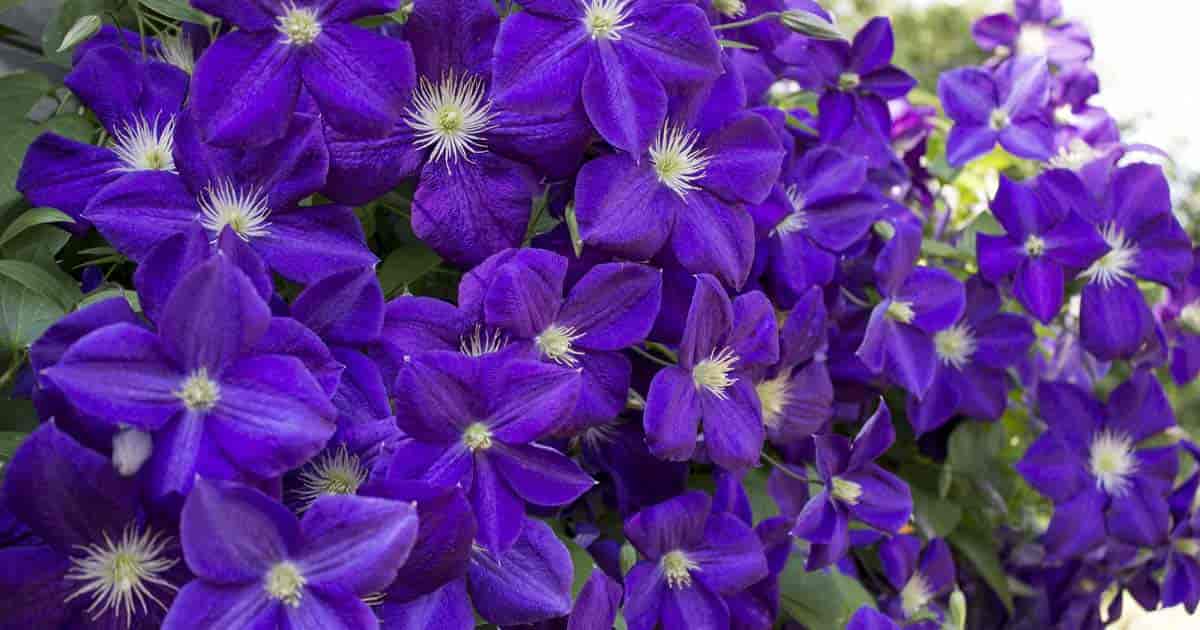 You want to make sure the plant has plenty of food to eat for a good start. Spread the roots so they fall in their natural positions and cover them with sharp sand or compost. This stimulates root growth and prevents the fertilizer from burning.
You want to make sure the plant has plenty of food to eat for a good start. Spread the roots so they fall in their natural positions and cover them with sharp sand or compost. This stimulates root growth and prevents the fertilizer from burning.
Use a gentle touch when planting, the delicate vine easily breaks. You don’t want to damage the crown or the emerging vines.
Plant slightly deeper than the pot it came in when purchased. Place the first set of leaves just under the soil and then gently fill the hole in with dirt.
For trellis, arbor and fence covering, space clematis from 6 to 12 feet apart, depending upon the vigor of the variety. Set the plants so their crowns are 1-1/2 to 2 inches below the ground level.
Fertilizing Clematis
Any plant that flowers so furiously is likely a greedy feeder. Happy plants will give amazing flowers to their owners.
The choice of commercial or organic fertilizer is yours. Feed in early spring, and again after flowering ends, but not later than the end of September. Don’t omit the annual application of lime.
Spray the plants and the soil around them with your favorite brand of liquid soluble fertilizer to maintain healthy new growth and ward off possible yellowing of the foliage, known as chlorosis.
Watering Your Clematis Plants
During the first year water plants weekly. This will ensure your plant becomes fully established and able to withstand the seasonal changes.
Baby your clematis the first year. Add a bit of mulch around the base of your plant to help keep in some moisture. However, be sure the mulch sits a few inches from the crown to avoid any fungus or root rot setting in.
Clematis object to poor drainage or standing water but like moisture. Never allow clematis to dry out.
Clematis Vine Care: Sun And Shade
Clematis thrive in six hours of sun per day. They appreciate some cool shade at their feet (roots) and the sun on their hair (the top of the plant).
The shade will help to keep the delicate roots cooler and the sun on the foliage will encourage growth and flowers.

Support For The Climbing Clematis
Clematis cling tightly to their support. Young plants need a little coaxing, tie them in an upright position. Full-grown specimens require some training and securing to prevent wind breakage.
Shorter varieties grown for your patio or balcony, won’t need much support. However, if you’re using a taller vine version of the plant (which most people prefer), you’re going to require some sort of support.
Clematis love to climb. They always search for something to climb up on and grab a hold of. Give it a railing, a trellis, a tree or something to vine up and around. They pair lovely with other plants that are in contrast to their color. The blooming clematis on a pergola is a georgous sight.
Keep in mind, the clematis doesn’t twine as a morning glory does, instead, it will wrap its leaf stems around the railing or other nearby plants.
For this reason, anything over one-half inch may be too large for it to twine around. In the early years give plants some additional support or assistance. Fishing line or a thin wire is an ideal solution to provide enough support.
The video below will help get you on your way of adding a clematis to your landscape or read the post from gardeners.com.
https://www.youtube.com/watch?v=dENbCJZ65QA
Pruning Clematis Vines and Opinions
There are almost as many opinions about pruning clematis as there are varieties.
Pruning Tips:
Species blooming in the spring months include:
- Clematis Montana rubens
- Clematis recta
- Clematis montaria unciulata
Do not prune until fall. However, remove dead wood in February or March.
Summer and fall varieties along with hybrids that bloom on new wood, do not prune until plants become well established.
Then, in the spring or fall cut the vines back to 3′ feet to encourage vigorous new growth.
Grower Tip: Use a colored thread to follow which vines are flowering each year to get the hang of it.
If plant height is desired, only remove dead wood and thin to insure strong growth. Severe pruning seems to encourage quality flowers.
Check out our article –> Planting Clematis in Fall
Fine Gardening shares this from their excellent article on pruning clematis:
When confronted with a tangle of spindly clematis vines to prune, many gardeners get no further than scratching their heads and wondering where to begin. The confusion is most likely caused by the specific pruning needs of the many species and varieties. Some clematis vines like to be cut to the ground each year. Others just need a simple shearing to keep them looking good. But how do you know what kind of pruning a clematis needs? The key to success is figuring out which of the three pruning groups your clematis belongs to. By identifying the group and following the instructions, the task will seem much less daunting. via finegardening
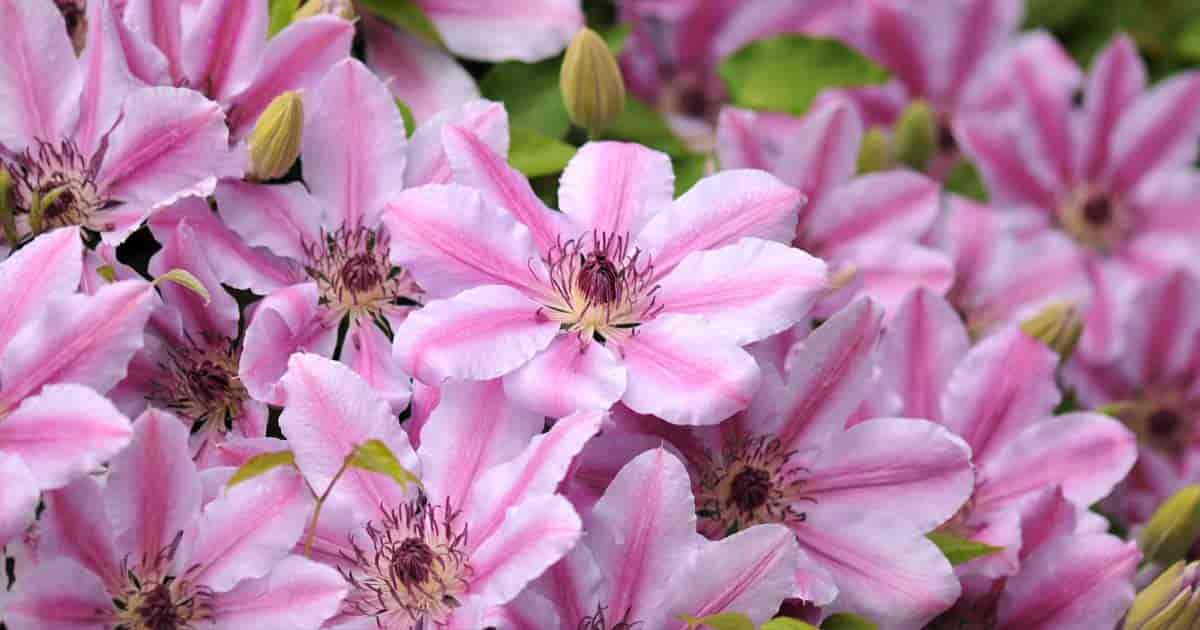
Pest & Disease Control on Clematis
In general, clematis are remarkably free of disease, especially in cooler climates. However, like all plants they do challenges of nature.
In the early spring before the new wood hardens, I like to apply Diatomaceous Earth for control of menacing slugs. Mice and rabbits like the young shoots in early spring as well. Discourage them with poison baits and commercial repellents or try these natural options.
Prune out root borer or crown borer.
Root-nematodes also called eel-worms, too small to see with the naked eye, reveal themselves by little protuberances on the roots. Consider them as a reason your plant is not thriving and there seems no other reason for its poor health.
Where or how they infest our gardens is a subject pathologists have long studied. Some think:
- Introduced in new soil
- Carried in by heavy rains or winds from nearby infected plants
- Manure in the bedding soil known to harbor and encourage growth of these pests.
Their presence shows up gradually by plants wilting especially after prolonged rains, or so it seems.
In cold weather regions, nematodes do not present a great problem, since most die in the winter.
Primarily in the warm climates of the Southern states nematodes become a major problem. Plants become stunted. The remedy – plant only disease-free plants.
Aphids with their tiny living hypodermic needles may infest clematis to a considerable degree. They suck the sap in leaves, cause them to turn brown and dry up.
Periodic applications with malathion or sprays with neem insecticide oils usually provides the best aphid control.
Clematis wilt disease causes a vine to suddenly wilt and die. Remove affected parts of the plant. Spray soil and remaining shoots with a fungicide. The disease may never recur. Don’t act too fast and discard a clematis attacked by wilt.
Stay alert for diseases like leafspot, characterized by small, tan, angular spots with red margins. Control it by clearing out diseased leaves and wood.
Spray the plants and soak the soil at the base with a solution of zineb (Dithane), two tablespoons per gallon of water. Start the treatment as soon as you see signs of trouble, and repeat every week or two for three or four times.
Stem rot is present when single shoots suddenly wilt and die. Infection occurs on stems near the soil line.
Remove infected stubs and spray the point of infection with a captan or Neem oil solution.
Iron chlorosis shows up in yellow leaves with green veins. Work either limestone or dolomite into the soil to overcome this.
Growing Clematis in Pots
Clematis grown in tubs or 10-inch pots make movable terrace and garden features.
Start small plants in 5-inch pots and plunge them into the ground. As growth progresses, move them to larger containers. Once a healthy specimen develops, move plants to any desired location.
Place drainage material in the bottom of the pot or tub and fill the container with rich soil. To the soil add leaf mold, lime and bone meal powder. Feed frequently, water well and encourage strong growth by growing the vines in a sunny location.
Begin training young plants using a wire frame or three tall bamboo stakes in tepee fashion. Don’t tie the shoots stiffly to the support. Allow some to grow upward and others to loop downward. To develop a thick base, pinch the tips of young growth.
Interesting “clematis trellis” found on twitter!
https://twitter.com/BeckGra/status/768033253597077504You can grow Clematis plants in pots for years, and good results achieved in the first year or two.
In southern areas, winter the pots or tubs in the ground. In northern regions mound the plants with sharp sand covered with leaves or salt hay.
Growing Clematis Indoors
Force clematis into bloom indoors or in a greenhouse during winter. Place young plant’s in a 4 or 5-inch pot containing a rich, loamy soil, as mentioned above for pot culture. Carefully stake the vine as it grows.
Provide a temperature of about 70° degrees Fahrenheit. Keep soil moist but not soggy, and spraying the vine with water is beneficial.
After flowering, cut back the vine, remove it from the pot and shake excess soil from the roots. Place it in a cool place for at least a month-long dormant period.
Then repot for continued indoor growing or plant outdoors in spring for summer blooming.
Clematis Propagation
Nurserymen and clematis specialists list nicely developed vines at modest cost. However, you may want to try your hand at propagating, using one or all of the three methods outlined below.
Rooting From Cuttings
In early summer, take cuttings of half-ripened wood, plant in sand and kept well shaded until rooted.
Many of the large-flowering varieties require gentle bottom heat for root formation. As soon as the roots have grown, pot the plants singly and keep them shaded until established.
Layering
Layering is a very simple method of propagation.
- In early spring select new shoots.
- Nick the shoot at the node.
- Pegged down into 6-inch pots plunged in the ground.
- Place a flat stone over the pegged part to prevent heaving during winter.
- The following spring young sever the plants from the parent to start life on their own.
Raising From Seed
Raising clematis from seed is a slow procedure. Seedlings require two or more years for the large-flowered hybrids to bloom.
Sow seeds in bulb pan with a layer of drainage in the bottom and fill the pans with sandy soil. Place the pans in a frame and keep shaded until germination occurs.
During the winter cover the pots with a wire cloth to prevent mice from getting the seeds. Expose seedlings to light very gradually. When large enough to handle, pot them up and keep in a frame until well established.
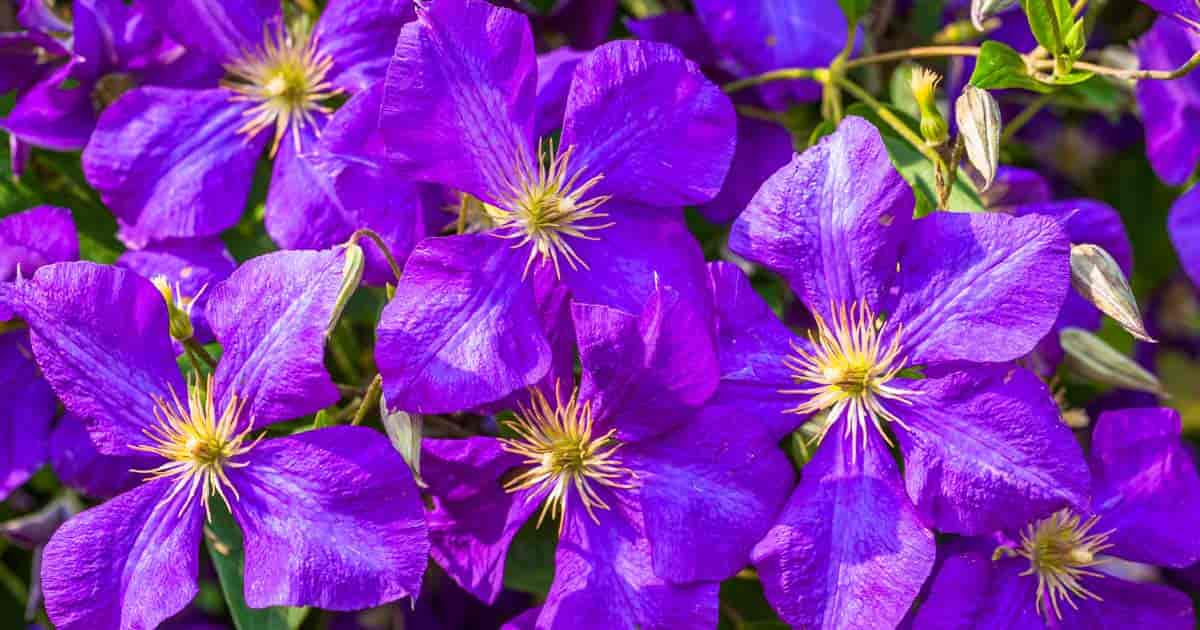
Representative Clematis Species List
Let’s face it; the large-flowered clematis hybrids are spectacular. However, the species they usually grow easier, are less problematic, and hardy in more widely varying climates.
As a guide to correct planting and pruning, they are grouped here according to time of bloom and whether they flower on new or old wood.
Species flowering in spring and early summer, on old wood, and pruned in early spring (March). Additional pruning only to thin, shape, and preserve the desired framework.
Clematis alpina – Alpine clematis, one of the earliest, with three-inch blue-violet flowers.
Clematis armandii – Armand or evergreen clematis, only moderately hardy. Masses of two-inch white star-flowers in spring.
Clematis chrysocoma – Hairy clematis, new leaves covered with golden-brown fur; clusters of two-inch white or pinkish flowers.
Clematis Florida – Cream clematis, semi-evergreen in mild areas; four-inch flowers white with green and purple markings.
Clematis macropetala – Downy or big-petal clematis, with soft-fuzzy, nodding, blue-violet flowers.
Clematis montana – Anemone clematis, not reliably hardy in New York; the variety rubens, with yellow-stamened pink flowers and bronzy-purple leaves has been grown successfully in Maine. Other varieties include alba, bountiful white star-flowers with golden stamens; and one usually listed as rosea ‘Apple Blossom,’ which may be a variety or hybrid of armandi. The soft, mauve-pink variety, undulata, is also probably a hybrid.
Clematis patens – Lilac clematis, southern native, with six-inch violet to white flowers.
Species flowering in late summer and fall, on new wood, pruned in late winter (February), and cut back severely. Trim plants to five live buds, or to living wood, or to the ground if winter-killed.
Clematis apiifolia – October clematis, a beautiful ground or bank cover with white flowers.
Clematis drummondi – Drummond clematis, native of Texas and Arizona. Soft-hairy leaves and white flowers.
Clematis flammula – Plume clematis, hardy to Virginia. Airy clusters of fragrant white flowers.
Clematis languinosa – Woolly-leaved or Ningpo clematis, with fuzzy foliage and large white flowers. White flowers of the variety candida have orchid shading on the margins.
Clematis orientalis – Oriental clematis, with clusters of two-inch yellow flowers.
Clematis paniculata – Sweet-scented autumn clematis, semievergreen in the South, grown successfully in Maine. Lovely ground cover with clusters of small white flowers followed by silky seed pods.
Clematis recta – Ground clematis, more or less shrubby, with panicles of fragrant white flowers.
Clematis tangutica – Golden clematis, flowers early with small golden bells, followed by silvery seed pods. The variety obtusiuscula has yellow flowers like a dangling tulip, will accept shade, and is hardy in Massachusetts.
Clematis vitalba – Old man’s beard, traveler’s joy. Hardy, native ground cover with inch-wide, fragrant white clematis flowers.
Clematis viticella – Italian clematis. Small clusters of rose-purple flowers with yellow stamens. Seeds may self-sow. Flowers of the variety kermesina, Kermes clematis, are wine red.
Some species may or may not be herbaceous, depending on climate and cultural conditions. When they die back, they grow up in spring from old wood rootstock and flower in summer or later. Where growth is not winter-killed, prune to living wood in March.
Clematis crispa – Marsh or curly clematis is a Southern native but has been grown with care in Maine. It bears slim, nodding, blue-purple flowers in midsummer.
Clematis jusca – Stanavoi clematis, with dangling violet pitcher-shaped flowers and brown-hairy leaves.
Clematis texensis – Scarlet clematis, may be listed as coccinea. It is easy to grow, and hardy to Maine. Flowers are like nodding scarlet urns, one inch long.
Clematis viorna – I.eather flower, native from Pennsylvania on down to Alabama. Dangling purple bell-shaped flowers in July.
Clematis virginiana – Virgin’s bower, grows wild at the roadside as far as Canada. Good ground cover, with clusters of white flowers. Sows its own ripe seeds.
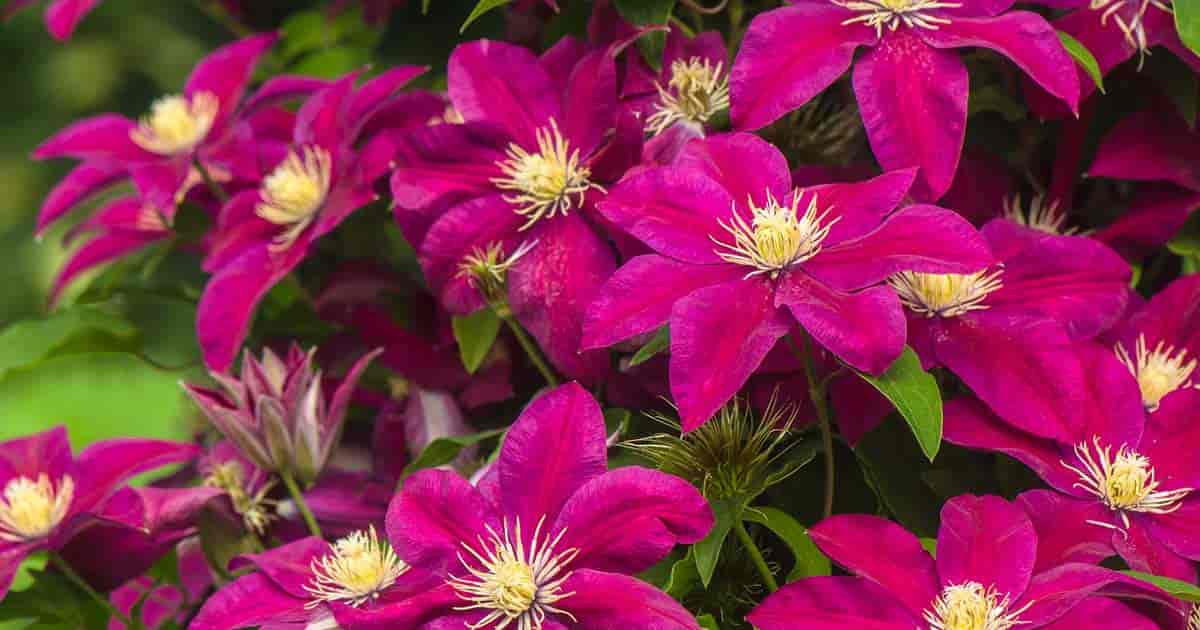
Clematis Vines, Plants, Flowers – Questions Answers
It’s been called the “Queen of the Climbers.” As with all plants Clematis can have its share of growing and care issues. Below are some answers to some of the questions submitted from our readers.
How To Start Clematis Vines From Cuttings
Question: How can I start new Clematis from cuttings? Last year I tried to root my cuttings but was not at all successful. Yet I have seen them started in this way. CB, Independence, OR
Answer: Clematis cuttings may be made either from soft new wood summer cuttings, or hardwood late fall cuttings. Take softwood summer cuttings in June or July using soft tips of branches four to six inches long.
Very young wood taken when the new branches are pushing and the first pair of leaves are about three-fourths grown makes ideal soft cutting material. The base of the cuttings should be dipped in a rooting hormone and then planted in pots, or in a cold frame, in a partially shaded location.
Try rooting them in a “soda-bottle greenhouse.” They should be watered just enough to prevent wilting and left undisturbed until the following spring then transplanted to a permanent location.
Yellow Leaves on Clematis
Question: Our clematis gets yellow leaves from the base of the plant about half way up the trellis. The vines blossom well but the leaves brown and destroy the looks of the plants. What can I do to remedy this condition? EB, Wisconsin
Answer: The plants should retain their foliage if the soil is limed and mulched and if it is not allowed to become too dry during mid-summer. The roots of clematis like a cool, moist, sweet soil.
Add limestone or hydrated lime, enough to make the ground white around the plant. Then mulch the soil with a rotted dressing to a depth of two inches. An occasional watering in addition to the mulch should keep the foliage green.
Purple Clematis Leaves Turn Yellow And Brown Then Dry Up
Question: I have a purple clematis. In early summer every year the leaves turn yellow and then brown and the vine dries up. It looks like a blight. Is there a spray or dusting powder that will prevent this?
Answer: There are several fungus diseases that attack the clematis. This particular one sounds like stem-rot. Pick off and destroy all diseased leaves and stems as soon as discovered. Spray with captan or zineb.
Cut Back The Tops On Clematis Jackmani Forcing It To Bloom Lower Next Spring?
Question: I have a jackmani or jackmanii clematis which for the last two years has come out only from the top. I wonder if I can cut back and force it to come out from below next spring or late summer.
Answer: Clematis jackmanii flowers from the terminal growths of long shoots. That is its nature. If you cut back the top and force it to come out near the ground it will likely break out and grow but it may bloom late spring the next growing season.
By that time it has made perhaps ten feet of new growth and very little has been gained. Why not bend the stalk of the plant down until the top is where you want it and peg the long stem to the ground or to the house.
Clematis – Indoors and Out
Question: Can Clematis be grown indoors and outdoors?
Answer: For a colorful late summer or fall vine either the large-flowered hybrids or the hardy clematis species are hard to beat. Spring is the time to plant them, although nursery container plants may be set out at any time.
Plant so the roots are shaded and mulch heavily. Top growth needs sunlight or partial shade. Organic matter and a handful or two of ground limestone should be worked deeply into the planting hole. Water the plants well and train them over a trellis or wall. No pruning is needed the first year.
138





